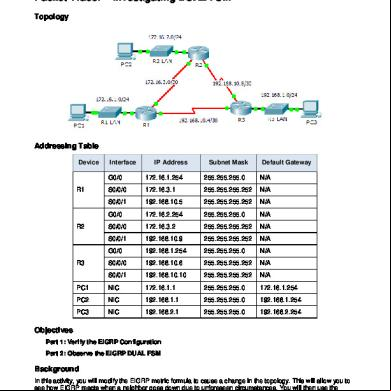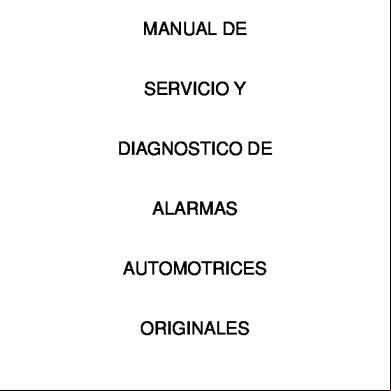1.3.2.5 Packet Tracer - Investigating Directly Connected Routes Instructions 2f68e
This document was ed by and they confirmed that they have the permission to share it. If you are author or own the copyright of this book, please report to us by using this report form. Report 2z6p3t
Overview 5o1f4z
& View 1.3.2.5 Packet Tracer - Investigating Directly Connected Routes Instructions as PDF for free.
More details 6z3438
- Words: 767
- Pages: 3
Packet Tracer - Investigating Directly Connected Routes Topology
Objectives Part 1: Investigate IPv4 Directly Connected Routes Part 2: Investigate IPv6 Directly Connected Routes
Background The network in the activity is already configured. You will to the routers and use show commands to discover and answer the questions below about the directly connected routes. Note: The EXEC is cisco and the privileged exec is class.
Part 1: Investigate IPv4 Directly Connected Routes Step 1: Use show commands to gather information about the IPv4 directly connected networks. Enter the following command on R1: R1> show ip route ? a. What option would be most beneficial in determining the networks assigned to the interfaces of the router? Show ip route b. Which networks are directly connected on R1? Hint: Use the option determined above. 172.31.20.0/23 is directly connected, GigabitEthernet0/0 172.31.22.0/23 is directly connected, GigabitEthernet0/1 209.165.200.224/30 is directly connected, Serial0/0/0 c.
Which IP addresses are assigned to the LAN interfaces on R1? 172.31.21.254/32 is directly connected 172.31.21.254/32 is directly connected 209.165.200.225/32 is directly connected, Serial0/0/0
© 2013 Cisco and/or its s. All rights reserved. This document is Cisco Public.
Page 1 of 3
Investigating Directly Connected Routes
d. Which networks are directly connected on R2? 172.31.24.0/24 is directly connected, GigabitEthernet0/0 172.31.25.0/24 is directly connected, GigabitEthernet0/1 209.165.200.224/30 is directly connected, Serial0/0/0 e. Which IP addresses are assigned to the LAN interfaces on R2? 172.31.24.254/32 is directly connected 172.31.25.254/32 is directly connected 209.165.200.226/32 is directly connected, Serial0/0/0
Step 2: PC addressing and test connectivity. a. Open a command prompt on PC1. Issue the command to display the IP settings. Based on the output, would you expect PC1 to be able to communicate with all interfaces on the router? Provide a short answer describing your expectations. Sí, porque la configuración es correcta y se puede hacer el ping entre las demás b. Open a command prompt on PC2. Issue the command to display the IP settings. Based on the output, would you expect PC2 to be able to communicate with PC1? your expectations. Sí, al hacer el pin ambas responden. c.
Determine the IP addresses of PC3 and PC4. Record the results and determine if PC3 and PC4 are able to communicate.
172.31.24.10 172.31.25.10 d. Test connectivity from PC1 to PC3. Was the test successful? Sí responde e. Bonus: Looking at the outputs of the routing tables on R1 and R2, what might indicate a reason for the success or failure of communication between PC1 and PC3? Tiene la misma IP el GigabitEthernet 0/0
Part 2: Investigate IPv6 Directly Connected Routes Step 1: Use show commands to gather information about the IPv6 directly connected networks. a. Which IPv6 networks are available on R1? 2001:DB8:C001:1::/64 2001:DB8:C001:2::/64 2001:DB8:C001:ACE::/64
b. Which IPv6 unicast addresses are assigned to the LAN interfaces on R1? 2001:DB8:C001:1::1/128 [0/0] 2001:DB8:C001:2::1/128 [0/0] 2001:DB8:C001:ACE::1/128 [0/0]
© 2013 Cisco and/or its s. All rights reserved. This document is Cisco Public.
Page 2 of 3
Investigating Directly Connected Routes
c.
Which IPv6 networks are available on R2? 2001:DB8:C001:3::/64 [0/0] 2001:DB8:C001:4::/64 [0/0] 2001:DB8:C001:ACE::/64 [0/0]
d. Which IPv6 addresses are assigned to the LAN interfaces on R2? 2001:DB8:C001:3::1/128 [0/0] 2001:DB8:C001:4::1/128 [0/0] 2001:DB8:C001:ACE::2/128 [0/0]
Step 2: PC settings and connectivity. a. Open a command prompt on PC1. Issue the command to display the IPv6 settings. Based on the output, would you expect PC1 to be able to communicate with all interfaces on the router? Provide a short answer describing your expectations Si al hacer ping responden entonces sí es posible b. Open a command prompt on PC2. Issue the command to display the IPv6 settings. Based on the output, would you expect PC2 to be able to communicate with PC1? your expectations Sí se hace el ping si responde. c.
Determine the IPv6 addresses of PC3 and PC4. Record the results and determine if PC3 and PC4 are able to communicate. 2001:DB8:C001:3::10/64 y 2001:DB8:C001:4::10/64
d. Test connectivity from PC1 to PC3. Was the test successful? Si hay conexión e. Bonus: What might indicate a reason for the success or failure of communication between PC1 and PC3 after looking at the outputs of the IPv6 routing tables on R1 and R2? Debido a la configuración de los routers permite las diferentes conexiones, creo.
Suggested Scoring Rubric Activity Section Part 1: Investigate IPv4 Directly Connected Routes Part 2: Investigate IPv6 Directly Connected Routes
Question Location
Possible Points
Step 1
25
Step 2
25
Step 1
25
Step 2
25
Total Score
100
© 2013 Cisco and/or its s. All rights reserved. This document is Cisco Public.
Earned Points
Page 3 of 3
Objectives Part 1: Investigate IPv4 Directly Connected Routes Part 2: Investigate IPv6 Directly Connected Routes
Background The network in the activity is already configured. You will to the routers and use show commands to discover and answer the questions below about the directly connected routes. Note: The EXEC is cisco and the privileged exec is class.
Part 1: Investigate IPv4 Directly Connected Routes Step 1: Use show commands to gather information about the IPv4 directly connected networks. Enter the following command on R1: R1> show ip route ? a. What option would be most beneficial in determining the networks assigned to the interfaces of the router? Show ip route b. Which networks are directly connected on R1? Hint: Use the option determined above. 172.31.20.0/23 is directly connected, GigabitEthernet0/0 172.31.22.0/23 is directly connected, GigabitEthernet0/1 209.165.200.224/30 is directly connected, Serial0/0/0 c.
Which IP addresses are assigned to the LAN interfaces on R1? 172.31.21.254/32 is directly connected 172.31.21.254/32 is directly connected 209.165.200.225/32 is directly connected, Serial0/0/0
© 2013 Cisco and/or its s. All rights reserved. This document is Cisco Public.
Page 1 of 3
Investigating Directly Connected Routes
d. Which networks are directly connected on R2? 172.31.24.0/24 is directly connected, GigabitEthernet0/0 172.31.25.0/24 is directly connected, GigabitEthernet0/1 209.165.200.224/30 is directly connected, Serial0/0/0 e. Which IP addresses are assigned to the LAN interfaces on R2? 172.31.24.254/32 is directly connected 172.31.25.254/32 is directly connected 209.165.200.226/32 is directly connected, Serial0/0/0
Step 2: PC addressing and test connectivity. a. Open a command prompt on PC1. Issue the command to display the IP settings. Based on the output, would you expect PC1 to be able to communicate with all interfaces on the router? Provide a short answer describing your expectations. Sí, porque la configuración es correcta y se puede hacer el ping entre las demás b. Open a command prompt on PC2. Issue the command to display the IP settings. Based on the output, would you expect PC2 to be able to communicate with PC1? your expectations. Sí, al hacer el pin ambas responden. c.
Determine the IP addresses of PC3 and PC4. Record the results and determine if PC3 and PC4 are able to communicate.
172.31.24.10 172.31.25.10 d. Test connectivity from PC1 to PC3. Was the test successful? Sí responde e. Bonus: Looking at the outputs of the routing tables on R1 and R2, what might indicate a reason for the success or failure of communication between PC1 and PC3? Tiene la misma IP el GigabitEthernet 0/0
Part 2: Investigate IPv6 Directly Connected Routes Step 1: Use show commands to gather information about the IPv6 directly connected networks. a. Which IPv6 networks are available on R1? 2001:DB8:C001:1::/64 2001:DB8:C001:2::/64 2001:DB8:C001:ACE::/64
b. Which IPv6 unicast addresses are assigned to the LAN interfaces on R1? 2001:DB8:C001:1::1/128 [0/0] 2001:DB8:C001:2::1/128 [0/0] 2001:DB8:C001:ACE::1/128 [0/0]
© 2013 Cisco and/or its s. All rights reserved. This document is Cisco Public.
Page 2 of 3
Investigating Directly Connected Routes
c.
Which IPv6 networks are available on R2? 2001:DB8:C001:3::/64 [0/0] 2001:DB8:C001:4::/64 [0/0] 2001:DB8:C001:ACE::/64 [0/0]
d. Which IPv6 addresses are assigned to the LAN interfaces on R2? 2001:DB8:C001:3::1/128 [0/0] 2001:DB8:C001:4::1/128 [0/0] 2001:DB8:C001:ACE::2/128 [0/0]
Step 2: PC settings and connectivity. a. Open a command prompt on PC1. Issue the command to display the IPv6 settings. Based on the output, would you expect PC1 to be able to communicate with all interfaces on the router? Provide a short answer describing your expectations Si al hacer ping responden entonces sí es posible b. Open a command prompt on PC2. Issue the command to display the IPv6 settings. Based on the output, would you expect PC2 to be able to communicate with PC1? your expectations Sí se hace el ping si responde. c.
Determine the IPv6 addresses of PC3 and PC4. Record the results and determine if PC3 and PC4 are able to communicate. 2001:DB8:C001:3::10/64 y 2001:DB8:C001:4::10/64
d. Test connectivity from PC1 to PC3. Was the test successful? Si hay conexión e. Bonus: What might indicate a reason for the success or failure of communication between PC1 and PC3 after looking at the outputs of the IPv6 routing tables on R1 and R2? Debido a la configuración de los routers permite las diferentes conexiones, creo.
Suggested Scoring Rubric Activity Section Part 1: Investigate IPv4 Directly Connected Routes Part 2: Investigate IPv6 Directly Connected Routes
Question Location
Possible Points
Step 1
25
Step 2
25
Step 1
25
Step 2
25
Total Score
100
© 2013 Cisco and/or its s. All rights reserved. This document is Cisco Public.
Earned Points
Page 3 of 3










